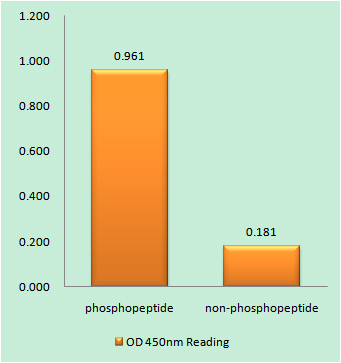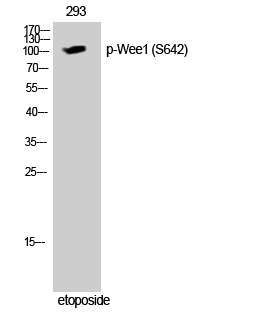
Catalog: KA1526C
Size
Price
Status
Qty.
96well
$470.00
In stock
0
Add to cart


Collected


Collect
Main Information
Reactivity
Human, Mouse, Rat
Applications
ELISA
Conjugate/Modification
Phospho
Detailed Information
Storage
2-8°C/6 months,Ship by ice bag
Modification
Phospho
Detection Method
Colorimetric
Related Products
Antigen&Target Information
Gene Name:
WEE1
show all
Other Name:
WEE1 ;
Wee1-like protein kinase ;
WEE1hu ;
Wee1A kinase
Wee1-like protein kinase ;
WEE1hu ;
Wee1A kinase
show all
Database Link:
Background:
catalytic activity:ATP + a [protein]-L-tyrosine = ADP + a [protein]-L-tyrosine phosphate.,cofactor:Binds 2 magnesium ions per subunit.,enzyme regulation:Synthesis is increased during S and G2 phases, presumably by an increase in transcription; activity is decreased by phosphorylation during m phase. Protein levels fall in M phase as a result of decreased synthesis combined with degradation. Activity seems to be negatively regulated by phosphorylation upon entry into mitosis, although N-terminal phosphorylation might also regulate the protein stability via protection from proteolysis or might regulate the subcellular location.,function:May act as a negative regulator of entry into mitosis (G2 to M transition) by protecting the nucleus from cytoplasmically activated cyclin B1-complexed CDC2 before the onset of mitosis. Its activity increases during S and G2 phases and decreases at M phase when it is hyperphosphorylated. A correlated decrease in protein level occurs at M/G1 phase, probably due to its degradation. Specifically phosphorylates and inactivates cyclin B1-complexed CDC2 reaching a maximum during G2 phase and a minimum as cells enter M phase. Phosphorylation of cyclin B1-CDC2 occurs exclusively on 'Tyr-15' and phosphorylation of monomeric CDC2 does not occur.,PTM:Phosphorylated during M and G1 phases. Also autophosphorylated.,PTM:Ubiquitinated and degraded at the onset of G2/M phase.,similarity:Belongs to the protein kinase superfamily.,similarity:Belongs to the protein kinase superfamily. Ser/Thr protein kinase family. WEE1 subfamily.,similarity:Contains 1 protein kinase domain.,
show all
Function:
M phase of mitotic cell cycle, mitotic cell cycle, M phase, nuclear division, protein amino acid phosphorylation,phosphorus metabolic process, phosphate metabolic process, cell cycle, mitosis, phosphorylation, cell cycle process,cell cycle phase, organelle fission, cell division,
show all
Cellular Localization:
Nucleus.
show all
Signaling Pathway
Reference Citation({{totalcount}})
Catalog: KA1526C
Size
Price
Status
Qty.
96well
$470.00
In stock
0
Add to cart


Collected


Collect
Recently Viewed Products
Clear allPRODUCTS
CUSTOMIZED
ABOUT US
Toggle night Mode
{{pinfoXq.title || ''}}
Catalog: {{pinfoXq.catalog || ''}}
Filter:
All
{{item.name}}
{{pinfo.title}}
-{{pinfo.catalog}}
Main Information
Target
{{pinfo.target}}
Reactivity
{{pinfo.react}}
Applications
{{pinfo.applicat}}
Conjugate/Modification
{{pinfo.coupling}}/{{pinfo.modific}}
MW (kDa)
{{pinfo.mwcalc}}
Host Species
{{pinfo.hostspec}}
Isotype
{{pinfo.isotype}}
Product {{index}}/{{pcount}}
Prev
Next
{{pvTitle}}
Scroll wheel zooms the picture
{{pvDescr}}


















